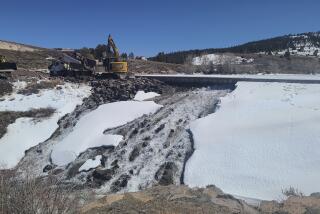Oroville hoping to turn dam crisis into a tourism opportunity

It was just a week ago that this city in the shadow of America’s tallest dam was in a state of crisis.
The town of 19,000 had been evacuated — along with dozens of other towns downstream — amid concerns the emergency spillway at the Oroville Dam might collapse, causing a massive flood.
Now, the crisis has eased, and the residents of Oroville are beginning to mull over how to move forward as the camera crews begin to depart and the national spotlight moves elsewhere.
Not far from the main drag through Oroville, a dozen local business owners and city officials faced each other in a hotel lunchroom Tuesday. They sought to begin developing an advertising campaign to transform a barrage of negative images and news reports about frantic efforts to prevent catastrophic flooding into a lucrative tourist attraction, albeit after the Feather River Basin’s rainy season ends in April.
That won’t be easy, acknowledged Jana Dawson Frazier, a local tour guide for the California Department of Water Resources, which operates the dam.
“I’m getting calls from people as far away as San Diego and San Jose who think the dam is failing – it is not,” Dawson Frazier said. “The problem is with its damaged spillways.”
The good news, she added with a smile, is that this sleepy agricultural city suddenly has a national audience it never counted on, and perhaps some will become future visitors.
For inspiration, the group looks to the newest hot spot in town: the Lake Oroville Visitors Center, which features a museum, a gift store and a 47-foot-tall tower with panoramic views of the commotion at the site.
“On a typical day, the center gets about 40 visitors,” Dawson Frazier said. “Right now, we’re seeing 1,200 to 1,300 visitors a day, and they all want a closer look at what they’ve been hearing about on the news.
“People who only a few weeks ago never knew we existed now know our name and where we’re located on a map,” she said. “I honestly think we can transform this situation into a tourism boon.”
The damaged spillway and the jet of water it produces drove Oroville resident Sue Snow to visit the dam for the first time Tuesday.
She remembered when Ronald Reagan, then the governor of California, came to Oroville for the dam’s dedication.
In the decades since, nothing compelled her to make the drive up the hill to a point overlooking the dam that’s now a visitors center.
“If someone had said this would happen, I wouldn’t have believed them,” said Snow, who visited with fellow resident Charlie Gaustad.
“We saw it on TV and said, ‘Well, let’s go!’” Gaustad said.
At the dam itself, officials said they got through the latest storm fine. Residents were allowed back into their homes last week and officials say they believe the situation has stabilized.
With the heaviest surge from a week of storms over, state water officials said Tuesday they were again considering shutting off the flow to Oroville Dam’s eroded main spillway to assess damage to the site and bring a nearby power plant back online.
People who only a few weeks ago never knew we existed now know our name and where we’re located on a map
— Jana Dawson Frazier, California Department of Water Resources tour guide
For three days, a pair of cranes on floating barges down river from the power plant has been waiting for a chance to go to work.
But state officials said they need calmer waters at the foot of the eroded spillway, which has been roaring and frothing for two weeks as engineers allowed water to flow out at millions of gallons a minute to lower the lake.
Bill Croyle, acting director of the DWR , said at a news conference Tuesday that the water flow into the lake peaked that morning and had since begun slowing. He said this gives engineers a chance to temporarily close the main spillway and get their clearest look yet at the 3,000-foot-long concrete structure’s damage without fears the reservoir will exceed capacity.
Estimates have put repairs of the spillway at $100 million or more, but Croyle said it’s too early to tell.
“Do we repair what we have? Do we replace what we have? Do we build the spillway somewhere else? All options are on the table,” said Croyle, who declined to provide a timetable for the spillway shut-off.
The main spillway rapidly eroded two weeks ago amid heavy storms and forced a shut-off. The lake then filled, and water poured onto an earthen emergency spillway that eroded and clogged the power plant’s intake with debris.
The emergency forced engineers to reopen the main spillway to lower the lake level, knowing it would further damage the structure.
Worried the dam could send a 30-foot wall of water to communities below if it failed, authorities ordered residents to evacuate.
The image of catastrophic flooding is definitely one of the challenges Oroville officials face as they try to get beyond the crisis.
Dawn Nevers, assistant city planner in Oroville, said the key is to turn the attention to the city’s benefit.
“We can’t let this event cripple the local economy,” Nevers said. “So, today we’re moving forward, all on the same page and preaching the same message: Oroville is strong and gorgeous.”
For breaking California news, follow @JosephSerna on Twitter.
ALSO
Gang member accused of killing Whittier cop had cycled in and out of jail, records show
Levee system battered by record rainfall from ‘atmospheric river’
A year after 20 bullets strike couple in fatal Inglewood police shooting, questions remain
More to Read
Start your day right
Sign up for Essential California for news, features and recommendations from the L.A. Times and beyond in your inbox six days a week.
You may occasionally receive promotional content from the Los Angeles Times.








